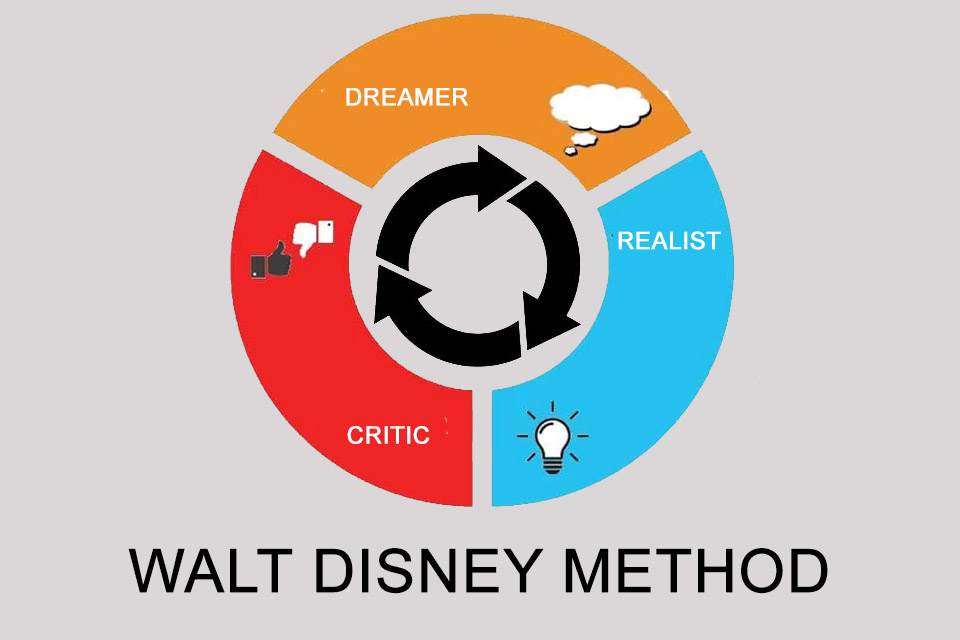What is the Walt Disney Method?
Smartpedia: The Walt Disney Method is a creativity method by which individuals or groups view a task from three different angles (as a dreamer, a realist and a critic).
Walt Disney Method – Creativity from Three Angles
The Walt Disney Method – also known as the Walt Disney Strategy or Disney Method for short – is a creativity method in which a task is examined from three different angles. It is suitable for individuals as well as for groups or teams. The method goes back to Robert Brian Dilts, an American author and neuro-linguistic programming consultant who wrote about the world-famous illustrator Walt Disney: “…there were actually three different Walts: the dreamer, the realist, and the spoiler”.
The Roles of the Walt Disney Method
The Walt Disney Method thus distinguishes three roles:
- The dreamer is enthusiastic and approaches the task with questions such as “What would be nice?”, “What would be the optimal situation?” or “What would I wish for?” The dreamer assumes that everything is possible.
- The realist takes a pragmatic approach and asks himself which materials, which knowledge, which techniques there are with which the thoughts of the dreamer can be realised. Sometimes the realist is also called the doer.
- The critic challenges the approaches of the dreamer and the realist by identifying opportunities and risks, pointing out limits and gaps, and expressing constructive and always positive criticism. The critic’s behaviour helps to identify possible sources of error.
In some variants of the Walt Disney method there is a fourth role: the neutral. He is an observer and consultant and supports both the orderly process and the concrete participants in their specific roles.
Application of the Walt Disney Method
The Walt Disney Method can be used both as an individual technique and as a group technique. The Walt Disney method works as a single technique, in which a problem is regarded by a person one after the other as a dreamer, realist and critic. As a role play in the group, different people take on the individual roles that they go through in subsequent rounds until each participant has taken each role once and/or a solution to the problem has been found.
As a result of the Walt Disney method, a list of answers to the following questions could be drawn up:
- What dreamlike ideas should be pursued?
- What realistic steps should be taken next?
- Which points need to be considered urgently during the implementation?
Tips for the Walt Disney Method
The Walt Disney method is suitable for many fields of work. It can be used for general idea generation, for the definition of corporate strategies, for the analysis of conflicts or problems, or for decision-making. There are a few tips on how to use the Walt Disney Method:
- The allocation of roles should always be clear and unambiguous for all those involved. For example, each role could be associated with a position in a room (the dreamer is in corner 1 of the office, the realist in corner 2, etc.). Or on the chairs where the employees take their roles, the role is clearly declared. This makes it easier for everyone involved to find their way around.
- Especially with untrained teams it can be useful to work with a moderator. He or she could, for example, mediate in controversies or try to work towards concrete results.
- The use of a timebox is useful so that each participant ideally receives the same speaking time.
- Even if participants take on different roles, the focus is on working together. It is about supporting each other and not about slowing each other down. This is the only way to find common answers from the different perspectives.
Impulse to discuss
The Walt Disney method requires a high degree of empathy from the participants in order not to appear “artificial”. If this empathy is not sufficiently developed in an organisation, it might be more sensible to use other methods such as brainstorming, brainwriting or brain dumping.
Notes:
Here you can find a German video: Kreativität fördern mit der Walt Disney Methode.
If you like the article or would like to discuss it, please feel free to share it in your network. And if you have any comments, please do not hesitate to send us a message.
And here you can find additional information from our t2informatik Blog:



